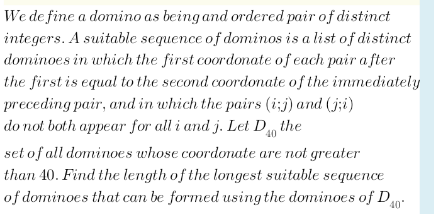
Question and Answers Forum
Permutation and CombinationQuestion and Answers: Page 1










|
Question and Answers Forum |
Permutation and CombinationQuestion and Answers: Page 1 |
| 10 couples are invited to a dinner. after the dinner they form pairs to dance. in how many ways can they do this, 1) generally 2) a man should dance with a woman 3) as 2), but two special couples should not dance with each other |
| there are 100 students in a school. it is found out that each student should select at least 4 courses, so that no two students have the same selection. how many different courses does the school offer? |
| 10 couples are invited to a dinner and should be seated at a round table. in how many ways can the host do this, 1) generally. 2) if the husband and the wife of each couple should sit together. 3) if no two men should sit next to each other. 4) as 3), but two speicial couples should not sit next to each other. it means that the husband from couple 1 may not sit next to the wife from couple 2 and the husband from couple 2 may not sit next to the wife from couple 1. but certainly the husbands of both couples may sit next to their own wifes. |
| P(5,6)=((15!)/((15−6))) = ((15!)/(9!)) =((15×14×131×2×11×10×9×8×7×6×5×4×3×2×1)/(9×8×7×6×5×4×3×2×)) =15×14×13×12×11×10 =3,603,600 |
| how many different words can be formed from the word MATHEMATICS? note: here a word should have at least two letters, but mustn′t have a meaning. |

|

|

|
| in how many ways can a teacher divide his 10 studens into 4 groups such that each group has at least 2 students? |

|
| Find the value of r, if ^(10) C_r = ^(10) C_(2r + 1) |
| (( ((n),(0) ) +3 ((n),(1) ) +5 ((n),(2) ) +...+(2n+1) ((n),(n) ))/( ((n),(1) ) +2 ((n),(2) ) + 3 ((n),(3) ) +...+n ((n),(n) ))) =((23)/(11)) n=? |

|
| Show that (π/4) < ∫_0 ^1 (√(1−x^4 ))dx using x = sint show that ∫_0 ^1 (√(1−x^4 ))dx<((2(√2))/3) using (∫_0 ^1 f(x)g(x)dx)^2 <∫_0 ^1 (f(x))^2 dx∫_0 ^1 (g(x))^2 dx |
| An ordered data consists of 6 even numbers and 4 odd numbers. The average of the odd numbers is 2022. The 3rd, 5th, 6th and 8 th numbers are odd. The data range is 24 , and the interquartile range is 14. The largest possible average of the ten numbers is ___ |

|
| log (x) = sin (x) x = ? |
| s |

|

|

|
| How many bit strings of length 11 have exactly three consecutive 1s? |
| How many bit strings of length 10 do not have four consecutive 1s? |

|